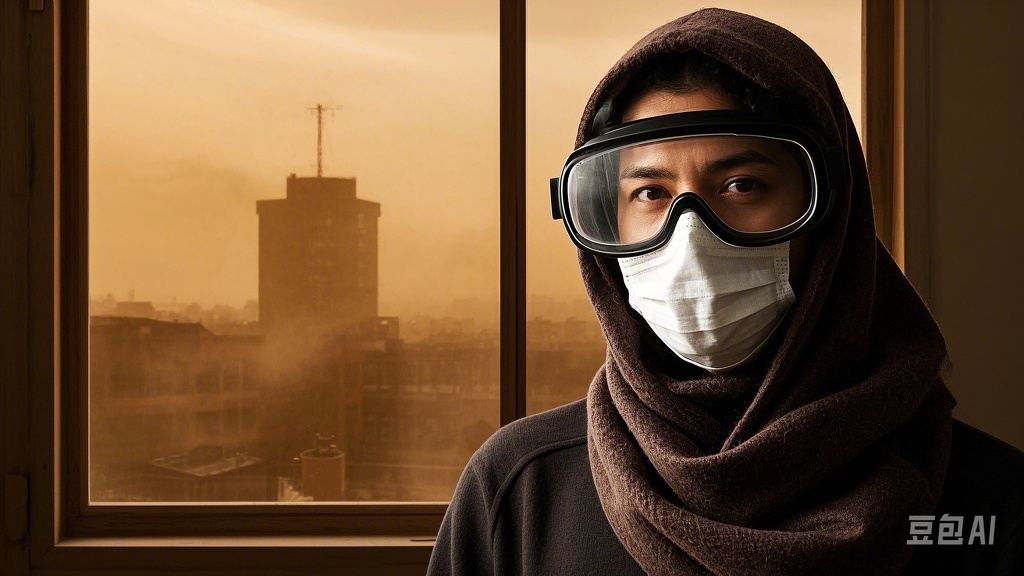
Since March 24, 2025, northern China has faced a severe environmental challenge as massive sandstorms swept through regions like Inner Mongolia, Xinjiang, and Beijing. These storms disrupted daily life, and posed serious health risks. While such extreme weather events are uncontrollable, proper preparation can significantly reduce their impact. Below is a practical guide to staying safe before, during, and after a sandstorm.
Living in areas vulnerable to sandstorms requires constant preparations. When outdoors, wear long sleeves and pants to protect your skin. Keep a portable emergency kit in your car or bag containing essential items: a high-quality face mask to filter dust, airtight goggles to protect your eyes, bottled water, and a warm blanket (crucial in winter storms to prevent a medical condition in which the body temperature is much lower than normal). Having these supplies on hand ensures you’re never caught unprepared.
If a sandstorm strikes, prioritize staying indoors. Close all windows, doors, and vents (通风孔) to block dust from entering your home. For those with allergies or issues connected with breathing, this step is vital to maintaining clean air indoors. If you must go outside, wear your mask and goggles immediately. In case these aren’t available, use a scarf or cloth to cover your nose, mouth, and ears, and pull your sleeves over your hands for extra protection.
Even after the storm passes, tiny dust particles can continue to exist in the air for days, worsening air quality. Use reliable tools like portable air monitors or apps to track pollution levels. The data helps you decide when it’s safe to resume outdoor activities. Additionally, clean your home thoroughly after the storm, wiping surfaces and using air purifiers to remove remaining dust.
Though sandstorms pose serious threats, knowledge and preparation can greatly reduce their risks. Residents in affected areas must avoid unnecessary outdoor exposure. By equipping ourselves with protective gear, and responding wisely during emergencies, we can safeguard our health.
原创编写 版权所有 侵权必究! 每日更新 个性化阅读 英语飙升!
1.1. What is the primary purpose of including a warm blanket in the emergency kit?
A To remove dust particles from the air.
B To protect hands from direct contact with sand.
C To prevent very low body temperature.
D To cover windows and block dust entry.
解析:选C。细节理解题。根据第二段的“a warm blanket (crucial in winter storms to prevent a medical condition in which the body temperature is much lower than normal)”可知,在冬季沙尘暴期间需要一条温暖的毯子,可预防体温过低。故选C。
2.2. What can be inferred about people with allergies or breathing problems during a sandstorm?
A They should immediately go outdoors for fresh air.
B They must avoid all physical activities until the storm passes.
C They need to use air purifiers instead of sealing windows.
D They are more dependent on sealing indoor air.
解析:选D。推理判断题。根据第三段的“Close all windows, doors, and vents to block dust from entering your home. For those with allergies or issues connected with breathing, this step is vital to maintaining clean air indoors.”可知,若沙尘暴来袭,优先留在室内。关闭所有门窗和通风孔,阻止灰尘进入家中。对于过敏或有呼吸问题者,此步骤对维持室内空气清洁至关重要。故选D。
3.3. What should people do immediately after a sandstorm ends?
A Go for outdoor activities once the wind stops.
B Use devices to track remaining dust levels.
C Clean their homes with water and soap.
D Throw away masks and goggles right away.
解析:选B。细节理解题。根据第四段的“Use reliable tools like portable air monitors or apps to track pollution levels.”可知,即使沙尘暴过去,微小灰尘颗粒仍可能在空气中存留数日,恶化空气质量。使用便携式空气监测仪或应用程序等可靠工具追踪污染水平。此外,彻底清洁家中环境,擦拭表面并使用空气净化器清除残留灰尘。故选B。
4.4. What conclusion can be drawn about sandstorm prevention?
A Individual preparedness plays a crucial role in risk reduction.
B Complete avoidance of storms is possible through technology.
C Government actions alone can solve air quality issues.
D Medical treatments are more effective than protective gear.
解析:选A。推理判断题。文中反复强调“proper preparation can significantly reduce their impact”(首段)、“equipping ourselves with protective gear”(末段),因此,个人的准备工作在减少沙尘暴危害风险方面起着至关重要的作用。故选A。